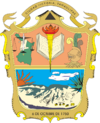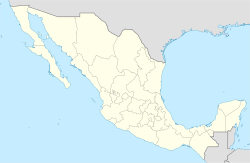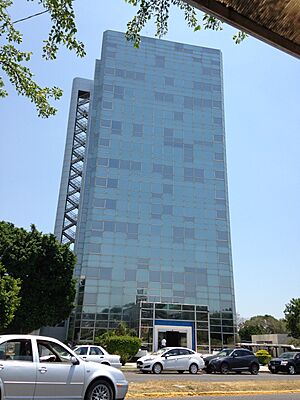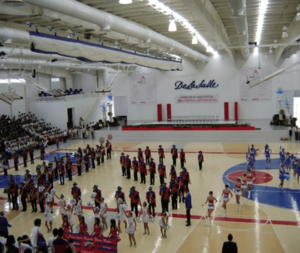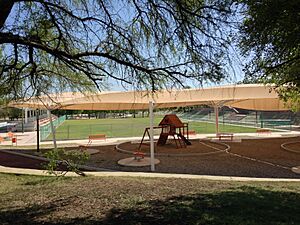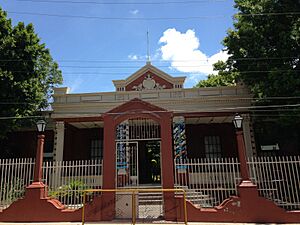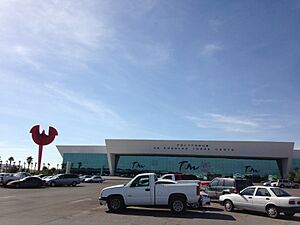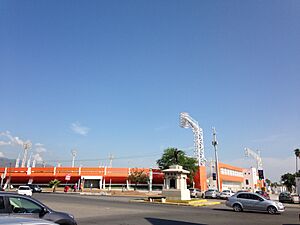Ciudad Victoria facts for kids
Quick facts for kids
Ciudad Victoria
|
||
|---|---|---|
|
City
|
||
| Ciudad Victoria | ||
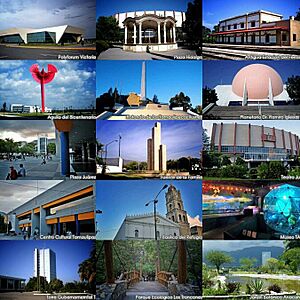 |
||
|
||
| Country | Mexico | |
| State | Tamaulipas | |
| Foundation | October 6, 1750 | |
| Founded as | Villa de Santa María de Aguayo | |
| Founded by | José de Escandón y Helguera | |
| Area | ||
| • City | 188 km2 (73 sq mi) | |
| Elevation | 316 m (1,037 ft) | |
| Population
(2022)
|
||
| • City | 432,100 | |
| • Density | 2,298/km2 (5,953/sq mi) | |
| • Metro | 349,688 | |
| Demonym(s) | Victorense | |
| Time zone | UTC−6 (CST) | |
| • Summer (DST) | UTC−5 (CDT) | |
Ciudad Victoria is the capital city of the Mexican state of Tamaulipas. It's located in the northeast part of Mexico, at the base of the Sierra Madre Oriental mountains. The city is named after Guadalupe Victoria, who was the first president of Mexico.
In 1825, Ciudad Victoria became the state capital. It's home to important schools like the Autonomous University of Tamaulipas. The city also has its own airport, General Pedro José Méndez International Airport. As the state capital, it's where the main government offices are located. It also has many interesting places for visitors.
Contents
- Discover Ciudad Victoria's History
- City Symbols
- People and Population
- Learning and Education
- Getting Around the City
- Local News and Media
- Fun and Culture
- Tamatán Zoo
- 21st Century Cultural and Recreational Park
- Tamatán Recreational Park
- Los Troncones Ecological Park
- Dr. Ramiro Iglesias Leal Planetarium
- Tamaulipas Cultural Centre
- Museum of Natural History of Tamaulipas (TAMUX)
- Regional Museum of History of Tamaulipas
- House of Art
- Juarez Theatre
- Tamaulipas International Festival
- Cultural Events
- Bicentennial Park
- Tamaulipas Fair
- Polyforum Dr. Rodolfo Torre Cantu
- City Services
- Sports in the City
- Delicious Food
- City's Location
- Partner Cities
- Famous People from Victoria
- Images for kids
- See also
Discover Ciudad Victoria's History
How the City Began
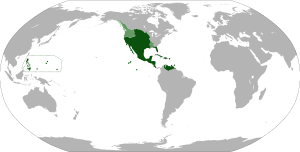
The area where Ciudad Victoria is now was first settled on October 6, 1750. It was founded as Villa de Santa María del Agua de Agüayo. This was part of a larger plan to settle the coast of the Gulf of Mexico.
The settlement was started by José de Escandon y Helguera. He chose a great spot, open to the east and protected by the Sierra Madre Oriental mountains to the west. This location also got cool breezes from the north and east.
Captain Juan de Astigárraga was in charge of the town. He helped build the first irrigation systems. This made farming much better and helped the population grow quickly. A Franciscan priest named Antonio Javier de Aréchaga also helped with religious matters.
Growth and Changes
After Captain Astigárraga passed away, Don Miguel de Córdoba took over. Under his leadership, the town continued to grow. By 1757, it had over 1,000 people. They owned many cattle and other animals, showing how well the town was doing.
The town was laid out in a perfect grid pattern. It became a central point for connecting with other settlements in the region. The San Marcos River provided plenty of water for farming corn and sugarcane. This helped the community thrive.
Becoming the Capital
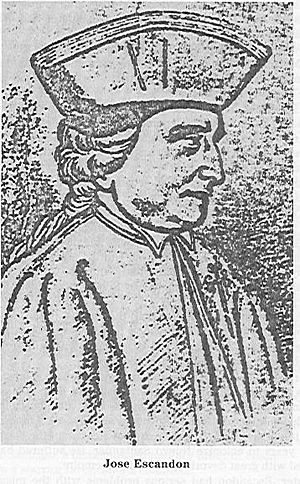
After Mexico gained independence, the region was renamed "Tamaulipas." On April 20, 1825, the state government officially made Villa de Aguayo a "City." It was also chosen as the capital of the state. The city was renamed Victoria to honor Guadalupe Victoria, Mexico's first president.
In 1846, during the Mexican–American War, American troops briefly occupied Ciudad Victoria. However, the city was freed when the war ended. Later, in 1898, a train system was built, connecting parts of the city. The beautiful Paseo Méndez park was also created around this time.
Modern Times
The city started to become more industrial in the late 1800s and early 1900s. New roads were built, connecting the capital to other parts of Mexico and the U.S. border. In 1939, the Marte R. Gómez Stadium was opened, which is still used today by the Correcaminos Football Club. The city's airport also started operating in 1941.
New government buildings were constructed in the mid-1900s, including the Government Palace and the Juárez Theatre. In 2010, Hurricane Alex caused some damage to the city. However, the city recovered and opened the "Bicentennial Park" government complex that same year. This park now holds most of the state government offices.
City Symbols
Coat of Arms
The coat of arms for Ciudad Victoria was designed on December 18, 1971. It has several symbols:
- A map of the state shows that Victoria is the capital.
- A balance, a sword, and a parchment stand for the three branches of government.
- A book represents education, and a torch means freedom.
- The date on the shield is when the city was founded.
- The landscape shows the natural environment when the founders arrived.
- Henequen plants represent the city's farming.
People and Population
City Population
According to a 2010 survey, Ciudad Victoria had about 446,029 people. Most of these people live in the city center. The population has been growing steadily.
In 2015, about 52% of the people in Ciudad Victoria were women. The city has about 211 people living in each square kilometer.
Religious Beliefs
Most people in Ciudad Victoria, about 90%, are Catholic Christians. About 5% are Protestant Christians. A small number of people follow other religions or no religion at all. Every year on December 12, there are big celebrations for the Virgin of Guadalupe. These celebrations include traditional dances, music, and fireworks.
Learning and Education
Schools and Universities
Ciudad Victoria offers many schools, from preschool to university. The number of people who can't read or write has gone down. Many people also go on to higher education.
The city has many schools:
- 57 special education schools
- 46 preschools
- 168 primary schools
- 55 secondary schools
- 46 high schools
- 3 middle-level professional schools
There are also 37 institutions for higher education.
Libraries
The "Marte R. Gómez" library is a well-known library in the city center. Ciudad Victoria has several other public libraries, including:
- The Adaberto J. Arguelles Municipal Public Library
- The Ernesto Higuera Public Library
- The Tamaulipas Municipal Cultural Centre Public Library
- The Ciudad Victoria Municipal Public Library
- The FOVISSSTE-SEP Municipal Public Library
- The Tamaulipas Regional History Museum Public Library
- The Paul Harris Municipal Public Library
Higher Education Institutions
- Autonomous University of Tamaulipas (UAT): This is the main public university in the city, founded in 1950. It has over 40,000 students.
- Technological Institute of Ciudad Victoria (ITCV): This was the first technology school in the area, starting in 1975. It offers undergraduate and postgraduate degrees.
- La Salle Victoria University (ULSA): A private Catholic university with programs in engineering, science, humanities, and health.
- Polytechnic University of Victoria (UPV): Opened in 2007, it's part of Mexico's technological university system. It offers engineering and postgraduate degrees.
- Centre for Research and Advanced Studies (CINVESTAV): This center has a technology lab in Ciudad Victoria.
There are also other universities and teacher training schools in the city.
Getting Around the City
Transportation
Ciudad Victoria has 32 bus routes that serve the city and nearby areas. Mini-buses and regular buses are the most common public transport. There are also taxi services and special school transport for university students.
The Pedro J. Méndez Airport is located just outside the city. Most of the city's main roads are paved, especially in the downtown area.
The city has a main bus station with routes to many other cities in Mexico, like Monterrey, Tampico, and Reynosa.
Main Roads
Some of the most important avenues and roads in Ciudad Victoria include:
- Av. Alberto Carrera Torres
- Francisco I. Madero Ave.
- Emilio Portes Gil Boulevard
- Blvr. Adolfo López Mateos
- Av. Rotaria
- Av. Carlos Adrián Aviles
- Calzada Gral. Luis Caballero
- Práxedis Balboa Boulevard
Federal highways Mexico 81 and Mexico 80 connect the city to places like Altamira and Tampico. The city also has pedestrian bridges and six bridges for cars that cross the San Marcos River.
Local News and Media
The city has telegraph and post offices for sending messages and packages.
For television, Ciudad Victoria has several open digital TV channels. These include popular networks like Imagen Television, Azteca Uno, Nueve, Azteca 7, Las Estrellas, and Canal 5.
Many radio stations broadcast in the city on both AM and FM. Some are owned by the state government, like XEVIC-AM and XHVIC-FM Radio Tamaulipas. Others are university stations or commercial stations playing different types of music.
Local newspapers like "The Journal of Ciudad Victoria" and "El Mercurio de Tamaulipas" provide daily news to the community.
Fun and Culture
Ciudad Victoria has many fun places to visit, including museums, a zoo, and beautiful parks.
Tamatán Zoo
The Tamatán Zoo is a great place to see different animals from around the world. It's designed to teach visitors about animal conservation and respect for nature. The zoo has different areas that show animals in spaces that look like their natural homes, with plants, rocks, and waterfalls.
21st Century Cultural and Recreational Park
This park has play areas for kids, a football field, and several swimming pools. It's also home to the Planetarium and the Tamux Museum. You can find a Botanical Garden and a green area called the Urban Forest here, perfect for walking and jogging.
Tamatán Recreational Park
This park offers many outdoor activities. It has green spaces, water features, playgrounds, and a restaurant. It's located on the land of a former large farm called Tamatán.
Los Troncones Ecological Park
Located in the mountains, this park is a beautiful natural spot. It's great for recreation and enjoying nature. You'll find a stream, waterfalls, and lots of plants and animals. The park has grills, gardens, and play areas for children.
Dr. Ramiro Iglesias Leal Planetarium
The Planetarium of Ciudad Victoria opened in 1992. It's a center for science and technology, showing documentaries and giving scientific talks. It's named after a famous Tamaulipas scientist, Dr. Ramiro Iglesias Leal.
Tamaulipas Cultural Centre
This is a cultural hub with a public library, the Amalia G. de Castillo Ledon theatre, a cinema, and several auditoriums. It hosts many cultural and artistic events like dance, music, sculpture, painting, literature, and theater.
Museum of Natural History of Tamaulipas (TAMUX)
The TAMUX museum opened in 2004. It focuses on science, nature, space, and promoting biodiversity. The planetarium is part of this museum. "TAMUX" is a word from the Huastec people that means "meeting point." The museum has different themed rooms, hosts scientific talks, and has an outdoor theater.
Regional Museum of History of Tamaulipas
This museum is located in an old building that was once an asylum. It opened in 2003 and shows visitors the rich cultural history of Tamaulipas. It has hosted many exhibitions from Mexico and other countries.
House of Art
The House of Art building was started in 1911. It used to be a teacher's school. Today, it offers courses and workshops in various artistic fields. Students can learn music, dance, visual arts, literature, and theater.
Juarez Theatre
This theater opened in 1957. It houses the Institute of Historical Research, which is part of the Autonomous University of Tamaulipas. The building features a beautiful mural by the painter Alfonso Xavier Peña.
Tamaulipas International Festival
Every October, the state of Tamaulipas celebrates this festival in all its cities. Ciudad Victoria hosts many musical and cultural events, including concerts, opera, and plays.
Cultural Events
On Sundays, Avenida Francisco I. Madero street in the city center becomes "Libre 17." It's a family-friendly space where people can walk, bike, and enjoy musical and cultural performances.
Bicentennial Park
This large park holds many state government offices. It also has a fairground with a fair, a performance center, and the Polyforum.
Tamaulipas Fair
This annual cultural event in the capital features classic mechanical rides. It also has stands from all the municipalities of Tamaulipas, showing off their culture and food. There are usually concerts by national artists. The performance center inside the fairground opened in 2008.
Polyforum Dr. Rodolfo Torre Cantu
This is a large convention center in Bicentennial Park, opened in 2009. It can be divided into several rooms and can comfortably hold 5,000 people.
City Services
Water and Drainage
The city's water and sewage services are managed by the Municipal Commission for Drinking Water and Sewerage of Ciudad Victoria (COMAPA). They plan, build, and maintain the water and sewage systems. Most of the water is used by homes (90.90%), with smaller amounts used by businesses, public areas, and industries.
Electricity
Almost all of Ciudad Victoria's population (97.50%) has access to electricity. The city has many streetlights, though some are not working. The Federal Electricity Commission (CFE) provides the electricity service.
Waste Collection
The city government collects garbage through various routes. About 370 tons of garbage are generated daily, and the city can collect about 200 tons each day.
Sports in the City
Ciudad Victoria has a lively sports scene. The professional football team, the Correcaminos of the Autonomous University of Tamaulipas, plays its games at the Marte R. Gómez Stadium. This stadium can hold 13,500 people. There's also the University Stadium Eugenio Alvizo Porras.
The Adolfo Ruiz Cortinez sports unit has facilities for football, volleyball, and an indoor gym for basketball. It also has a baseball stadium.
The Sports Centre of Ciudad Victoria, named "Américo Villareal Guerra," is a modern facility. It has spaces for gymnastics, fencing, weightlifting, diving, swimming, athletics, boxing, judo, archery, and basketball. It's mainly used by top athletes who represent Tamaulipas in national sports events.
Delicious Food
Local Dishes
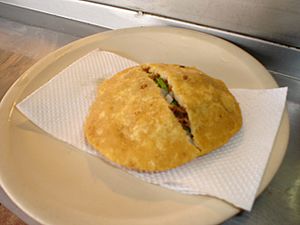
The food in Ciudad Victoria often features meat, corn, and seafood. You'll find grilled meat, dried meat, and chorizo. One of the most famous local foods is the gordita. These are small, thick corn tortillas filled with tasty ingredients like shredded meat, nopales (cactus paddles), scrambled eggs, or beans. Many restaurants also serve classic Mexican food like "taquitos."
Sweets and Desserts
For Desserts, the region offers treats made with walnut, sweet potato, and cocadas (coconut candies) with pineapple and walnut. You can also enjoy crystallized fruits and sweet gorditas made with piloncillo (unrefined whole cane sugar).
City's Location
Geography and Climate

Ciudad Victoria is located about 316 meters (1,037 feet) above sea level. It's just north of the Tropic of Cancer. The city sits in a valley between two mountain ranges: the Sierra Madre Oriental to the west and the Sierra de Tamaulipas to the east.
The city has a climate that is a mix of humid subtropical and hot semi-arid. This means it has short, warm winters and long, very hot summers. Temperatures rarely drop below 0°C (32°F). The highest temperature ever recorded was 48.5°C (119.3°F), which is one of the highest in Mexico!
The city gets about 740 mm (29 inches) of rain each year. Most of this rain falls between May and October. Sometimes, strong storms from the Atlantic Ocean bring very heavy rains.
Partner Cities
Ciudad Victoria has special partnerships with other cities, both in Mexico and the United States. These partnerships help with economic development and cultural exchange. Some of its sister cities include:
- Matamoros, Mexico
- Reynosa, Mexico
- Tampico, Mexico
- Nuevo Laredo, Mexico
- Ciudad Mante, Mexico
- Monterrey, Nuevo León
- Chilpancingo, Guerrero
- McAllen, Texas (since 2008)
- San Luis Potosí, San Luis Potosí (since 2010)
- Mazatlán, Sinaloa (since 2014)
Famous People from Victoria
Many notable people have come from Ciudad Victoria, including:
- Emilio Portes Gil: A former governor of Tamaulipas and a former president of Mexico.
- Arleth Terán: A Mexican television actress.
- Carlos Peña Rodríguez: A professional football player.
- Alan Pulido Izaguirre: A professional football player.
- José Sulaimán: A businessman and boxing official.
- Rosemary Barkett: A Federal Judge in the United States.
- Ismael Valdez: A Major League Baseball player.
Images for kids
See also
 In Spanish: Ciudad Victoria para niños
In Spanish: Ciudad Victoria para niños


